Conjugated bile acids activate the sphingosine-1-phosphate receptor 2 in primary rodent hepatocytes
- PMID: 21932398
- PMCID: PMC3245352
- DOI: 10.1002/hep.24681
Conjugated bile acids activate the sphingosine-1-phosphate receptor 2 in primary rodent hepatocytes
Abstract
Bile acids have been shown to be important regulatory molecules for cells in the liver and gastrointestinal tract. They can activate various cell signaling pathways including extracellular regulated kinase (ERK)1/2 and protein kinase B (AKT) as well as the G-protein-coupled receptor (GPCR) membrane-type bile acid receptor (TGR5/M-BAR). Activation of the ERK1/2 and AKT signaling pathways by conjugated bile acids has been reported to be sensitive to pertussis toxin (PTX) and dominant-negative Gα(i) in primary rodent hepatocytes. However, the GPCRs responsible for activation of these pathways have not been identified. Screening GPCRs in the lipid-activated phylogenetic family (expressed in HEK293 cells) identified sphingosine-1-phosphate receptor 2 (S1P(2) ) as being activated by taurocholate (TCA). TCA, taurodeoxycholic acid (TDCA), tauroursodeoxycholic acid (TUDCA), glycocholic acid (GCA), glycodeoxycholic acid (GDCA), and S1P-induced activation of ERK1/2 and AKT were significantly inhibited by JTE-013, a S1P(2) antagonist, in primary rat hepatocytes. JTE-013 significantly inhibited hepatic ERK1/2 and AKT activation as well as short heterodimeric partner (SHP) mRNA induction by TCA in the chronic bile fistula rat. Knockdown of the expression of S1P(2) by a recombinant lentivirus encoding S1P(2) shRNA markedly inhibited the activation of ERK1/2 and AKT by TCA and S1P in rat primary hepatocytes. Primary hepatocytes prepared from S1P(2) knock out (S1P(2) (-/-) ) mice were significantly blunted in the activation of the ERK1/2 and AKT pathways by TCA. Structural modeling of the S1P receptors indicated that only S1P(2) can accommodate TCA binding. In summary, all these data support the hypothesis that conjugated bile acids activate the ERK1/2 and AKT signaling pathways primarily through S1P(2) in primary rodent hepatocytes.
Copyright © 2011 American Association for the Study of Liver Diseases.
Figures
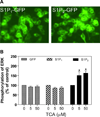
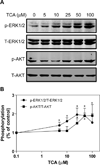
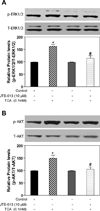

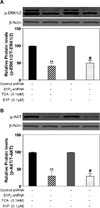

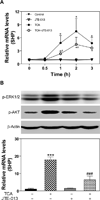
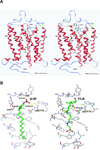
Similar articles
-
Conjugated bile acids promote ERK1/2 and AKT activation via a pertussis toxin-sensitive mechanism in murine and human hepatocytes.Hepatology. 2005 Dec;42(6):1291-9. doi: 10.1002/hep.20942. Hepatology. 2005. PMID: 16317705
-
Taurocholate Induces Cyclooxygenase-2 Expression via the Sphingosine 1-phosphate Receptor 2 in a Human Cholangiocarcinoma Cell Line.J Biol Chem. 2015 Dec 25;290(52):30988-1002. doi: 10.1074/jbc.M115.668277. Epub 2015 Oct 30. J Biol Chem. 2015. PMID: 26518876 Free PMC article.
-
The role of sphingosine 1-phosphate receptor 2 in bile-acid-induced cholangiocyte proliferation and cholestasis-induced liver injury in mice.Hepatology. 2017 Jun;65(6):2005-2018. doi: 10.1002/hep.29076. Epub 2017 Apr 28. Hepatology. 2017. PMID: 28120434 Free PMC article.
-
Bile acids are nutrient signaling hormones.Steroids. 2014 Aug;86:62-8. doi: 10.1016/j.steroids.2014.04.016. Epub 2014 May 10. Steroids. 2014. PMID: 24819989 Free PMC article. Review.
-
Bile acids and sphingosine-1-phosphate receptor 2 in hepatic lipid metabolism.Acta Pharm Sin B. 2015 Mar;5(2):151-7. doi: 10.1016/j.apsb.2014.12.009. Epub 2015 Feb 9. Acta Pharm Sin B. 2015. PMID: 26579441 Free PMC article. Review.
Cited by
-
Developmental origins of NAFLD: a womb with a clue.Nat Rev Gastroenterol Hepatol. 2017 Feb;14(2):81-96. doi: 10.1038/nrgastro.2016.160. Epub 2016 Oct 26. Nat Rev Gastroenterol Hepatol. 2017. PMID: 27780972 Free PMC article. Review.
-
Intestinal Absorption of Bile Acids in Health and Disease.Compr Physiol. 2019 Dec 18;10(1):21-56. doi: 10.1002/cphy.c190007. Compr Physiol. 2019. PMID: 31853951 Free PMC article. Review.
-
G protein-coupled receptor 35 attenuates nonalcoholic steatohepatitis by reprogramming cholesterol homeostasis in hepatocytes.Acta Pharm Sin B. 2023 Mar;13(3):1128-1144. doi: 10.1016/j.apsb.2022.10.011. Epub 2022 Oct 13. Acta Pharm Sin B. 2023. PMID: 36970193 Free PMC article.
-
In vivo mouse models to study bile acid synthesis and signaling.Hepatobiliary Pancreat Dis Int. 2023 Oct;22(5):466-473. doi: 10.1016/j.hbpd.2023.08.009. Epub 2023 Aug 12. Hepatobiliary Pancreat Dis Int. 2023. PMID: 37620226 Free PMC article. Review.
-
Role of FXR in Bile Acid and Metabolic Homeostasis in NASH: Pathogenetic Concepts and Therapeutic Opportunities.Semin Liver Dis. 2021 Nov;41(4):461-475. doi: 10.1055/s-0041-1731707. Epub 2021 Jul 21. Semin Liver Dis. 2021. PMID: 34289507 Free PMC article. Review.
References
-
- Thomas C, Pellicciari R, Pruzanski M, Auwerx J, Schoonjans K. Targeting bile-acid signalling for metabolic diseases. Nat Rev Drug Discov. 2008;7:678–693. - PubMed
-
- Nguyen A, Bouscarel B. Bile acids and signal transduction: role in glucose homeostasis. Cell Signal. 2008;20:2180–2197. - PubMed
-
- Lefebvre P, Cariou B, Lien F, Kuipers F, Staels B. Role of bile acids and bile acid receptors in metabolic regulation. Physiol Rev. 2009;89:147–191. - PubMed
-
- Zhang Y, Edwards PA. FXR signaling in metabolic disease. FEBS Lett. 2008;582:10–18. - PubMed
Publication types
MeSH terms
Substances
Grants and funding
LinkOut - more resources
Full Text Sources
Other Literature Sources
Miscellaneous
